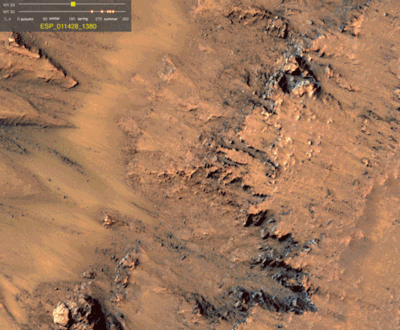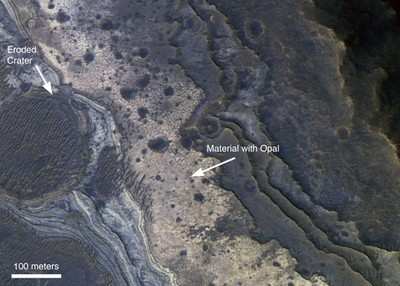Surface Water Likely Existed Only In Short Periods, If At
All
A new NASA study suggests if life ever existed on Mars, the
longest lasting habitats were most likely below the Red Planet's
surface.
NASA Image

A new interpretation of years of mineral-mapping data, from more
than 350 sites on Mars examined by European and NASA orbiters,
suggests Martian environments with abundant liquid water on the
surface existed only during short episodes. These episodes occurred
toward the end of hundreds of millions of years during which warm
water interacted with subsurface rocks. This has implications about
whether life existed on Mars and how its atmosphere has
changed.
"The types of clay minerals that formed in the shallow
subsurface are all over Mars," said John Mustard, professor at
Brown University in Providence, R.I. Mustard is a co-author of the
study in the journal Nature. "The types that formed on the surface
are found at very limited locations and are quite rare."
Discovery of clay minerals on Mars in 2005 indicated the planet
once hosted warm, wet conditions. If those conditions existed on
the surface for a long era, the planet would have needed a much
thicker atmosphere than it has now to keep the water from
evaporating or freezing. Researchers have sought evidence of
processes that could cause a thick atmosphere to be lost over
time.
NASA Image

This new study supports an alternative hypothesis that
persistent warm water was confined to the subsurface and many
erosional features were carved during brief periods when liquid
water was stable at the surface. "If surface habitats were
short-term, that doesn't mean we should be glum about prospects for
life on Mars, but it says something about what type of environment
we might want to look in," said the report's lead author, Bethany
Ehlmann, assistant professor at the California Institute of
Technology and scientist at NASA's Jet Propulsion Laboratory in
Pasadena. "The most stable Mars habitats over long durations appear
to have been in the subsurface. On Earth, underground geothermal
environments have active ecosystems."
The discovery of clay minerals by the OMEGA spectrometer on the
European Space Agency's Mars Express orbiter added to earlier
evidence of liquid Martian water. Clays form from the interaction
of water with rock. Different types of clay minerals result from
different types of wet conditions.
During the past five years, researchers used OMEGA and NASA's
Compact Reconnaissance Imaging Spectrometer, or CRISM, instrument
on the Mars Reconnaissance Orbiter to identify clay minerals at
thousands of locations on Mars. Clay minerals that form where the
ratio of water interacting with rock is small generally retain the
same chemical elements as the original volcanic rocks later altered
by the water.
NASA Image

The study interprets this to be the case for most terrains on
Mars with iron and magnesium clays. In contrast, surface
environments with higher ratios of water to rock can alter rocks
further. Soluble elements are carried off by water, and different
aluminum-rich clays form.
Another clue is detection of a mineral called prehnite. It forms
at temperatures above about 400 degrees Fahrenheit (about 200
degrees Celsius). These temperatures are typical of underground
hydrothermal environments rather than surface waters. "Our
interpretation is a shift from thinking that the warm, wet
environment was mostly at the surface to thinking it was mostly in
the subsurface, with limited exceptions," said Scott Murchie of
Johns Hopkins University Applied Physics Laboratory in Laurel, Md.,
a co-author of the report and principal investigator for CRISM.
One of the exceptions may be Gale Crater, the site targeted by
NASA's Mars Science Laboratory mission. Launching this year, the
Curiosity rover will land and investigate layers that contain clay
and sulfate minerals.
 SpaceX to Launch Inversion RAY Reentry Vehicle in Fall
SpaceX to Launch Inversion RAY Reentry Vehicle in Fall Aero-News: Quote of the Day (04.23.24)
Aero-News: Quote of the Day (04.23.24) Aero-News: Quote of the Day (04.20.24)
Aero-News: Quote of the Day (04.20.24) ANN's Daily Aero-Linx (04.20.24)
ANN's Daily Aero-Linx (04.20.24) Aero-News: Quote of the Day (04.21.24)
Aero-News: Quote of the Day (04.21.24)





